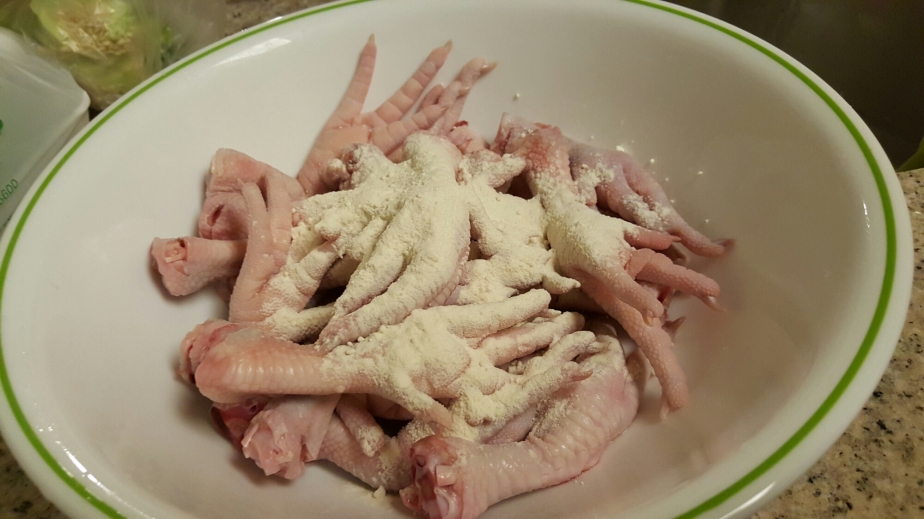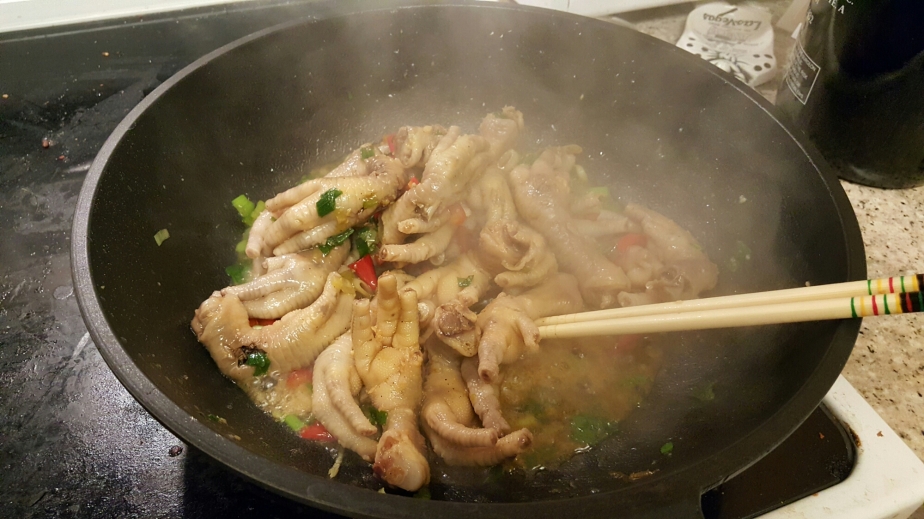I know what you’re thinking. Chicken feet? And no, I’m not trying to have my own Bizarre Foods-esque blog here. Truth is, throughout most of Asia, chicken feet is not really considered all that exotic. If you go to a dim sum restaurant and look around, most tables with have chicken feet.
As I stated on my last post, I am challenging myself, at least for the time being until I find a better idea, to cook using an ingredient I have never used before. So why not make my first post with something I love eating but never thought to make at home?
To start off, I guess I will describe the difference between Chinese and Korean style of chicken feet, at least from a taste point of view. Chinese chicken feet, commonly found in dimsum restaurants, are sweet and savory. They sometimes are cooked with some black bean sauce. Korean chicken feet are usually fried or made super spicy. It is more common as a bar food. There are other variations, including a soy sauce based version, but I thought I’d generalize them to give you a better sense of regionality.
Chicken feet has no meat on them as is mostly consisted of collagen and tendons. The skin becomes almost gelatinous and has a textural similarity to Pork’s feet. (Yes. Pork’s feet. That may have to be a separate post, considering how odd that may sound to most Americans) Actually, I made modified a recipe I found to better reflect the similarities between chicken feet and pork feet. I used similar spices to when I make my pork feet. The spicy sauce is actually the same sauce used to make Spicy Pork Feet. (Go figure huh?)
I won’t get too detailed on the recipe because I wrote the recipe on Yummly. But I thought I’d share the experience with you.
Experience
(recipe here)
To start, I have time say, raw chicken feet is not easy to look at if you’re not used to it.

Worst of all is the feel of them. I feel like I am holding a dead baby’s arm when working with the chicken feet. No I don’t know what it feels like to hold a dead baby’s arm but I imagine it would feel similar.
You start off by draining the blood in cold water for an hour. Then comes the cleaning process. You scrub the chicken feet well with a coarse salt like Kosher salt. This help remove any impurities on the skin. Then you rub the chicken feet with flour to remove any unwanted smells. (I’ll get to that a little later)

After rinsing the chicken feet thoroughly, you boil them with onions and ginger to further remove pungency.
About the pungency, or pungent meat flavor. When it comes to a lot of Asian recipes, especially Korean, a lot of what goes into the recipe is to remove what we would call it “pungent meat” smell and taste. In western cooking, a lot of what we attribute to flavor in meat, is considered undesirable in Korean cooking. Koreans like simpler and cleaner flavors. The removal of these unwanted smells and flavors make more sense when you consider recipes that call for cooking the meat for long periods of time. A bone marrow soup cooking for more than 8 hours will really concentrate the flavors and the unwanted smells will become a lot more apparent when not dealt with properly. Western cooking deals with this also, usually by use of dry rubs, use of garlic, herbs, cooking in high heats for short periods, etc. Koreans will do everything to get rid of any trace of the unwanted pungency. We drain the blood in cold water, we cook with alcohol to evaporate the smells, add onions, garlic, peppercorn. Another thing that is commonly done in Korea to get rid of these smells actually can be told in the next step of the recipe.
Bring a pot of water to a boil, with onions, garlic, and ginger. I added some other spices (star anise, cloves) that I use when I boil the water for pork feet.
After boiling the chicken feet for 10 min., rinse the chicken feet under cold water to clean the surface of the feet and cool down the meat.
This boiling and discarding the water process is crucial to get rid of the unwanted smells.
After all that is done, I trimmed the tip of the fingers to remove the nails. Most recipes call for it to be done early on, but I thought it would be easier to remove when it was slightly cooked and no blood was running.
Then I stir-fried the green onions and garlic, then added the chicken feet with soy sauce, sake, and ginger. This is to remove any last hints of pungency. Most recipes call for making the sauce first before stir-frying. However, due to the high heat cooking and that the ingredients are prone to getting burnt, I decided to build the sauce as I stir-fry. This was a “know-how” I saw on TV by a famous Korean chef who specializes in Chinese Cuisine. This method came from his way of making chicken feet.
I added the veggies at the end so I can keep the crunch.
Once the stir fry is done, I wrap it around in aluminum foil and cook it in the oven for 10 more min. at 400 degrees. I like this because it gives a better textural quality that I love.
After taking it out of the oven, I plate it on a large dish and serve right away.
All in all, the dish came out exactly how I wanted. I learned a lot while researching different ways to cook chicken feet. I always thought they battered the chicken feet and stir-fried the chicken feet in sauce. I realized that the skin just has that quality after cooking this recipe







